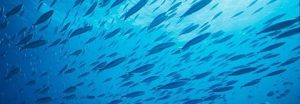Fish
This is one of a series of articles on food written by David Murray (see the full list on the right hand sidebar).
 As far back as human history goes, fish has always been on the menu. Other than not being too bright, and thus relatively easy for the savvy human to catch, they have long provided us with essential sustenance and health benefits.
As far back as human history goes, fish has always been on the menu. Other than not being too bright, and thus relatively easy for the savvy human to catch, they have long provided us with essential sustenance and health benefits.
You may have heard of Omega 3 fatty acids. But don’t let the ‘fatty’ or ‘acid’ parts send you running for the hills! These are essential fats. You MUST eat them, because your body can’t make them on its own. And they do wonderful things for your heart.
Omega 3 can be found in various foods, but fish is one of the highest sources. And as your best friend will tell you as you bawl your eyes out on their shoulder over your lost love, there are plenty of fish in the sea.
Now either your friend has been misled, or has given that same advice to an absurd number of people. Global fish supplies are in decline, and according to the UN, the global fishing fleet is 2.5 times larger than is sustainable. What’s more, 4% of those vessels take the same amount of fish as the remaining 96% take from the ocean.
While overfishing of a species is a problem, the larger problem is a little thing known as ‘bycatch’. Those industrial fishing boats (some of which rival entire island nations for their fishing capacity) often use FADs (Fish Aggregating Devices) and a net known as a purse seine. The combination of these allow the boat to catch a much greater number of fish, but also include other species that are not wanted. Bycatch species often include dolphins, turtles, and even baby whales.
Not surprisingly, the general public isn’t too happy about the levels of bycatch and has pushed for a more eco-friendly fishing method. Enter Line Caught Tuna.
‘Line caught’ is another method of fishing that involves towing a long fishing line with many hooks behind a boat. This results in much less bycatch and is the preferred method of fishing by Greenpeace.
It used to be the case that line caught fish cost up to three times more than conventionally caught fish, but nowadays the prices are much more comparable. More and more fish providers are switching to the line catching method, and our oceans are all the better for it.
There are a few labels to understand and be wary of when buying fish. Just because something is advertised and “dolphin friendly” doesn’t mean they are doing anything special, or doing anything at all. For example, most species of tuna can be fished dolphin-free to begin with. It’s easy to assume that this is synonymous with Line Caught, but it isn’t.
The next is ‘organic’. When it comes to fish, the application of the word ‘organic’ may surprise you. Most of our fish comes from ‘wild’ fisheries, where the eco-system is not moderated by humans. This may seem like the perfect place to slap an organic label, but you’d be wrong. No wild fisheries can claim to be organic, only farming fisheries. And there is a whole host of other issues associated with fish farms. Disease and parasites are much more common, and the impact on the environment is also substantial.
So put some fish in your dish!
It’s good for you, and the RIGHT fish is good for your planet.
